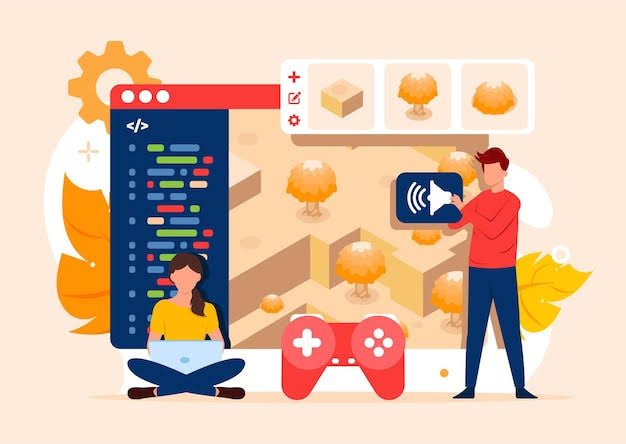Trends in Augmented Reality (AR) Apps

Within a very short period of time, augmented reality has emerged as one of the most influential technologies of the 21st century. AR intertwines the spaces of physical and digital by making interactive, computer-generated over-the-top elements both augment and enhance the user's impression of reality. From enhanced smartphones to faster Internet access, better AR software has really fueled the growth of AR applications in all sectors, from entertainment, retail, education, to healthcare. As AR continues to evolve further, new trends are shaping the future of this technology. As it evolves, developers and users unlock innovative possibilities. We then discussed the most important trends in AR applications that enable a better comprehension of how technology transforms our world.
AR in Retail and E-commerce
Perhaps most obviously in the development of AR is that it is particularly relevant in the domains of retail and e-commerce, where it makes life easier for the consumer to actually see the product on the shelf before its actual purchase, thereby increasing engagement and conversion rates.
- AR-Powered Virtual Try-Ons: Brand names in this market include Sephora and L'Oréal, which have created AR-powered apps allowing virtual try-ons so that one can see how a piece of makeup or glasses or a shoe would look before the purchase. Adoption levels as seen thus far are quite considerable, more in fashion and beauty industries. It minimizes the rates at which returns are made, thus increasing satisfaction for customers since they get the exact style, color, and size desired from home.
- AR Product Visualization: IKEA and Amazon are using AR to enable customers to visualize how the furniture or household item would look in the house. Customers can place virtual models of products in their physical space, thereby getting a better understanding of size, color, and aesthetics. It's something that not only improves the experience of shopping but also increases customers' confidence in making purchasing decisions.
- Future Potential: And this is only the beginning of the future of AR in retailing; with the advancement of AR glasses and wearable devices, consumers can now browse virtual stores with augmented displays or virtually interact with the digital products in a physical store to provide smooth online-offline shopping experiences.
AR in Education and Training
Augmented reality is slowly rising as an enhancement tool to a learning experience. The ability to superimpose information onto objects and environments in the real world offers so much richness to education and training in a vast number of disciplines.
- Interactive Experiences: Educational applications based on AR provide students with the opportunity to visualize and interact with complicated concepts relating to various subjects such as science, history, and geography. Applications, for example, AR Chemistry Lab allows students to perform simulated chemistry experiments while the AR-based history applications recreate ancient civilizations, thus making the learning process more captivating and memorable. Through these interactive simulations, abstract concepts become easier to understand thereby improving retention and learning outcomes.
- Corporate Training and Professional Development: Applications in the corporate world include employee training and development. Most corporations, whether they are in their sectors of operation of manufacturing, healthcare, or aviation use AR applications to give hands-on training without much material. Therefore, an AR application can be employed to walk workers in following on how to perform machinery maintenance by superimposing step-by-step instructions onto the equipment. In healthcare, AR is also used to simulate surgeries and medical practices so that trainees, risk-free, could practice in controlled environments.
- Future Possibilities: In the near future, we expect training and education to continue to trend towards the application of AR technology. Devices obviously are going to become much less expensive going forward, but their use in the classroom and in professional training for skill development will continue. Tomorrow's AR apps may include virtual classrooms whereby students interact with 3D models and other interactive content, or professional development centers practicing skills in augmented reality environments.
Gaming and Entertainment Using AR
The industry that has been one of the earliest adopters of AR technology is in gaming: it goes with games like Pokémon Go and Harry Potter: Wizards Unite, which are among the most popular mobile AR games. This is because as hardware and software advance, gaming experiences become more immersive and interactive.
- Location-Based AR Games: Location-based AR gaming, Pokémon Go showed this world as it took the way mobile gaming evolved and was literally incorporated into gamified physical environments. These incorporate the use of GPS in combination with AR technology to overlay virtual objects that recreate real-world locations, challenging players to navigate around the places; the trend now shows the trend is growing continuously with new ideas developed by developers that create some ideas blending the physical with the digital world in rather innovative ways .
- Multiplayer AR Experience: AR is also making new forms of social and multiplayer gaming possible. Multiplayer AR games will be able to enable synchronous collaboration or competition in real-time over shared augmented environments. For example, HoloGrid: Monster Battle is an AR-based game that brings tabletop gaming to life with the help of virtual monsters that appear on a board. As AR cloud continues to advance, synchronized interactions will occur for multiplayer AR experiences and collaborations and competitions will be able to happen within the same augmented space.
- Potential Future: In the future, AR can really be very influential in creating fully immersive gaming environments that coexist perfectly with the real world. Later, once AR glasses and haptic feedback technology evolve, gamification will be far more touch and immersion-oriented as players might interact with virtual objects through a tangible sensation.
Health Care Industry
The healthcare industry is rapidly using AR technology to improve the care of patients, medical training, and operations. AR apps are enabling medical practitioners to visualize patient data and simulate complex medical procedures.
- Diagnostic Accuracy: AR is also improving diagnostic accuracy with the help of various AR apps that can visualize patient data, simulate complex medical procedures, and improve diagnostic accuracy.
- AR-Assisted Surgery: Some of the most promising uses of AR in healthcare include surgery augmented by AR. During surgery, one can overlay 3D models of a patient's anatomy onto the body to help surgeons see detailed, real-time data generated during the procedure. This enhances precision and minimizes risk. Platforms like HoloLens, developed by Microsoft, are being applied in complex surgeries such as spinal and brain surgeries in a bid to improve outcomes.
- Medical Training and Education: Training healthcare practitioners is also one of the purposes of AR. Apps such as Touch Surgery make use of AR in bringing students through a surgical procedure, thus allowing a student to practice surgery in virtual space. Increased incorporations of AR simulations are being increased in medical schools, giving students an interactive experience over page-to-page textbook reading and learning anatomy and other subjects.
- Future Potential: Also, it can be highly applied in operation rooms and training as more enhanced AR hardware becomes available. Future applications of AR may also consist of artificial intelligence for real-time diagnostics, predictive analysis, and automated assistance with surgery.
AR in Real Estate and Architecture
This is in the real estate and architecture industries as AR is used to give a view of what the client's property or their architectural designs will be like before it is built. Therefore, AR applications provide an immersive experience that allows clients to "walk through" buildings or rooms in 3D, even if they are not there.
- Virtual Tours of Property: AR allows real estate firms to offer a virtual property tour, eliminating the necessity for visualizing properties in two dimensions by using 2D floor plans or photos. A buyer or tenant can go through a house in three dimensions, seeing the layout, the sizes of the rooms, and design elements in an interactive fashion. This practice intensified in the wake of the COVID-19 pandemic, during which real estate agents needed to offer virtual tours as a suitable replacement for in-person visits.
- AR in Architecture and Construction: Applications of AR in architecture and construction include the use in visualizing designs on-site. Architects and builders can superimpose a 3D model over an actual environment to evaluate what a design would look like in a real environment. This enhances better planning and design iteration in addition to presenting to clients. AR can also help construction workers to see what the blueprints and instructions would look like on-site, thus reducing error-prone activity and achieving efficiency.
- Future Development: AR will be a key design and construction tool, allowing architects, builders, and clients to share real-time experiences in the augmented environment. As we advance with AR technology, we may gain more sophisticated tools to let users create their designs directly in the augmented space and simulate construction processes.
Social Media and Marketing utilizing AR
It is an adoption that social media has taken of AR, through the capacity of the user to create engaging and interactive content. AR filters, stickers, and effects keep making applications such as Instagram, Snapchat, and TikTok popular since users discover a new way of expressing themselves.
- AR Filters and Effects: Snapchat popularized AR filters by explaining to its users how to superimpose funny, creative effects over their photos and videos. Many other applications, in turn, began using AR tools and offering Instagram and TikTok the integration of adding virtual elements to content. Brands use these AR filters more to create an interactive marketing campaign while encouraging use of their products in different manners.
- AR-Fuelling Ads and Campaigns: AR is revolutionizing the face of advertising because brands are now able to create ad experiences that feel much more like participation, not observation. For example, Facebook and Google also work on AR ad formats so that users are able to interact with the product tapping the ad with their smartphone. A user could try on virtual sunglasses or see how a certain furniture piece looks in a living room directly from an ad.
- Future Potential: AR to seamlessly integrate with social media and marketing will continue and become more personalized and immersive. Soon, expect brands to design campaigns that use facial recognition to allow people to interact with products in real-time according to preference.
AR for Navigation and Tourism
It is changing the way we find our ways within a city or abroad. Overriding directions, landmarks, and other points of interest onto the physical environment basically makes travel more intuitive and informative.
- AR Navigation: Google Maps has lately implemented the AR feature, using the camera to project walking directions on the real world. This makes it more accessible for users to explore around the city without much hassle in navigation. Some of the applications of AR navigation apps include providing turn-by-turn directions with street view projections, to be able to guide people better through crowded towns or even indoor, like airports or malls.
- AR in Tourism: AR will transform tourism through the creation of an interactive and educative traveling experience. Various AR applications, such as ViewRanger and Historypin, can enhance the experience of exploring historical monuments and cultural heritage by the content of augmented reality. Users must point their smartphones at a landmark to see historical facts, images, or 3D reconstructions about what this site may have looked like in the past.
- Potential of the Future: Future cities and tourist destinations will probably be characterized by the growing influence of AR and fast, personalized contextual information about what surrounds one. Advanced tools for navigation using AR in the future could involve leading an individual along vast buildings or transport hubs.
AR in Art and Culture
The museums, galleries, and artists are nowadays experimenting with AR to come up with interesting cultural experiences. It is changing how people interact with art and cultural heritage, including virtual exhibitions, interactive installations, and many more.
- AR Art Installations: The sense of incorporating AR into art installations is being created by artists who play with demarcations between digital and physical environments. For example, with AR, one can project dynamic digital visuals onto a sculpture. Hybrid works in the arts change and shift over time. Apps, such as Artivive, provide spectators with an opportunity to discover augmented reality-infused art exhibitions as they add layers of digital content to more traditional art. The historic artifact and cultural heritage is being animated with the help of AR. Now, museums are marrying up these exhibits with AR apps, so that visitors can view the virtual reconstructions of the ancient artifacts, buildings, and environment. AR apps provide additional context or information about exhibits, which makes the experience really richer.
- Future Potential: This would go on to play a critical role toward democratizing access to art and culture. As the tools of AR become easier to handle, more avenues for artists and institutions to address new audiences, making cultural experiences unique and personalized.
Integrating Chatbots for Enhanced User Interaction
Today, every business has to have chatbots as a tool in order to increase user interaction and communication. This feature can be incorporated into websites, apps, and even customer service interfaces. This allows a firm to provide its users with immediate, personalized experiences through direct instantaneous assistance. Here are the benefits of using chatbots for enriching user interaction:
1. 24/7 Availability
With a business using chatbots, it can be set up to provide support and services 24/7. Human agents respond sometime after too much deliberation, while chatbots spring into action instantaneously, responding to the questions that users have at any particular time; it aids in solving common issues fast, ensuring that users do not wait for answers.
2. Personalized User Experience
Chatbots can give recommendations tailored to each customer based on their preferences or behavior or previous activities. For example, an e-commerce website may make recommendations through chatbots on a customer's previous purchase history or even browsing history.
3. Instant Query Resolution
Chatbots are designed to provide users with quick instant answers about relatively common customer questions. This reduces the need to browse FAQs or wait for a customer service representative, which increases user satisfaction with minimized support-related costs.
4. Seamless Multi-Channel Support
Chatbots can be leveraged across all platforms-websites, social media, and mobile apps-to facilitate a seamless continuum of experiences. Users will have a consistent experience no matter where they're engaging with the brand. They can switch across platforms easily without losing context.
5. Richer User Engagement
How well the chatbot engages the users would depend on the type of questions it asks, interactive content provided, or updates and reminders it sends. A travel website may ask users about their preferences while traveling and suggest some possible destinations or deals for them.
6. Richer Customer Onboarding
For apps or software platforms, chatbots can help the user on the onboarding process with detailed step-by-step instructions, answering questions, and providing hints. This improves the time taken by a user to get started with it and minimizes the learning curve.
7. Lead Generation and Qualification
Chatbots can gather information from users and qualify leads by asking relevant questions or data about the preferences and needs of the users. This will have a direct impact on a sales team working on high-quality leads, making the chances of conversion more likely.
8. Multilinguality
This is the feature whereby chatbots can render support in more than one language effectively doing away with language bias, and companies can, therefore, service their customers in different parts of the world. It's very effective for companies that deal mainly with foreign clients or for businesses interacting in multilingual regions.
9. Cost Efficiency
Chatbots also integrate, which reduces the need for a large customer service team as they can handle much of the queries from users. This lowers operational costs while ensuring that the users receive their services in time.
10. Data Collection and Analytics
Interaction with chatbots comes in handy, as it provides great data by businesses to analyze the behavior, preferences, and pain points of customers. All these data elements can be used to refine the services, improve marketing strategies, and make better contributions to the users.
By integrating chatbots into a business's digital platforms, user interaction will become instantly convenient, customized, and efficient. Whether it's improving engagement, quick query resolution, or seamless multi channel support, the use of chatbots is now indispensable in molding customer experiences and upsurging business growth.
Augmented Reality evolves to shape and transform industries and mold the way we engage with the world around us. AR applications have broken into the new possibilities for innovation and engagement, both in retail and healthcare, gaming, and education. With future developments and improvements in hardware and software in AR, further promising experiences in immersive interaction and personalization are in store with time. And indeed, the future for AR is bright because its potential lies in not knowing its bounds as it continues to change our reality beyond our own imagination.
Recent Stories
500k Customer Have
Build a stunning site today.
We help our clients succeed by creating brand identities.
Get a Quote





















































































































